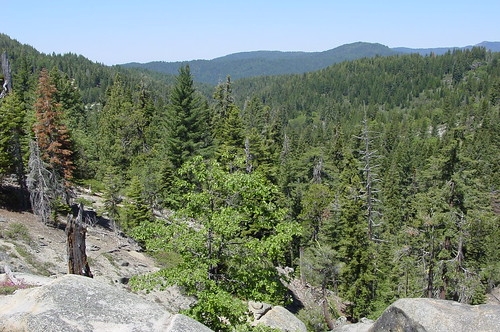Previous tree mortality and density big factors in the devastating 2020 Creek Fire
Wildfires burning in western U.S. forests have increased in size and severity since the late 20th century, with a number of recent fires exhibiting characteristics that match the criteria for mass fires – or fires that burn with high intensity over large continuous areas for long durations of time.
Operational fire behavior models, commonly used by federal and state fire suppression agencies to predict how wildfires will behave, cannot predict mass fire behavior, largely because they do not include the important combustion and fire-atmosphere interactions. The Creek Fire, which exhibited mass fire behavior when it burned through the southern Sierra Nevada in 2020, was analyzed to better understand the mechanisms and forest conditions that contribute to devastating wildfires.
Scott Stephens, Alexis Bernal and Brandon Collins in the Department of Environmental Science, Policy and Management at University of California, Berkeley, along with other colleagues used both ground-based and remotely sensed data to analyze behavior patterns of the 2020 Creek Fire to determine which variables were important in predicting fire severity.
Findings indicated that dead biomass and live tree density were the two most important variables – more so than treatment history (i.e. timber harvesting, fire hazard reduction treatments, etc.), fire history or topography. Areas with the highest amounts of dead biomass and live tree densities were also positively related to high-severity fire patch size — indicating that large homogenous swaths of these types of conditions resulted in adverse, landscape-scale fire effects.
“Forest restoration must be increased greatly in California forests, the Creek Fire shows us what will happen if we don't move decisively ” said Stephens, lead author on the work, which is published in a new paper in the journal Forest Ecology and Management.
Additional analysis revealed that although the first two days of the Creek Fire were abnormally hot and dry, weather during the days of the greatest fire growth was largely within the normal range for the time of year (late summer). The spatial distribution of fire intensity during those days, however, revealed some notable patterns, with the concentration of heat from the fire being in the opposite location of where it would be expected. Specifically, on the day of the largest fire growth (Sept. 6), not only was the greatest heat concentrated away from the fire perimeter (or “flaming front,” which is the expected location for heat concentration), but a significant amount of heat was still being generated within the previous day's fire perimeter. This finding is critical to better understanding how traditional fire behavior models may or may not accurately predict fire behavior in forests that have large, contiguous areas of dead trees and high live tree density – an increasingly common forest fuel condition in Sierra Nevada forests.
The findings of this study have important implications for forest managers, as they indicate that in certain forest structures (i.e. those with large, homogenous swaths of dead biomass or high densities of live trees) conventional fire models may dramatically underpredict the spread rate and area burned because these models do not correctly capture the physics driving the fire.
The Creek Fire is one of a number of fires that shows how vulnerable forests are to current frequent-fire forest conditions, suffering high tree mortality and offering fuel conditions capable of generating mass fires from which future forest recovery is questionable because of type conversion and probable reoccurring high severity fire.
The study, titled “Mass Fire Behavior Created by Extensive Tree Mortality and High Density Not Predicted by Operational Fire Behavior Models in the Southern Sierra Nevada,” was published online on May 16 in the journal Forest Ecology and Management.
The authors of the paper are:
- Scott Stephens, Department of Environmental Science, Policy and Management, University of California, Berkeley.
- Alexis Bernal, Department of Environmental Science, Policy and Management, University of California, Berkeley.
- Brandon Collins, Department of Environmental Science, Policy and Management and Center for Fire Research and Outreach, University of California, Berkeley.
- Mark Finney, USDA Forest Service, Rocky Mountain Research Station.
- Chris Lautenberger, Reax Engineering.


